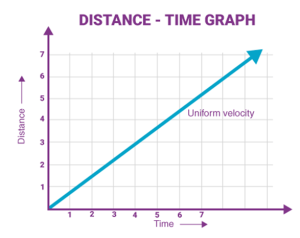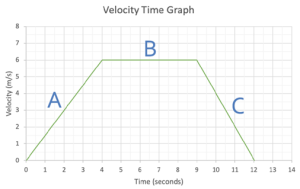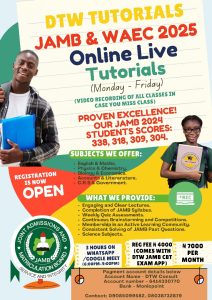2.0 INTRODUCTION
Motion is the change in position of an object with respect to time. It can be described in terms of displacement, distance, speed, velocity, and acceleration.
TYPES OF MOTION
- Linear Motion: Motion along a straight line.
- Rotational Motion: Motion around an axis.
- Periodic Motion: Motion that repeats at regular intervals (e.g., pendulum).
- Random Motion: Motion that does not have a fixed path (e.g., gas molecules).
- Translational Motion: Motion in which all parts of an object move in the same direction and distance. It can be linear or rotational (e.g. a train moving along a track).
- Oscillatory Motion: A type of periodic motion where an object moves back and forth around a central point or equilibrium position (e.g. a mass attached to a spring or a swing).
- Circular Motion: Motion along a circular path. It can be uniform (constant speed) or non-uniform (changing speed); (e.g A car going around a circular track or a satellite orbiting a planet).
- TERMS RELATED TO CIRCULAR MOTION
- Centripetal Force: The net force directed towards the centre of the circle, keeping the object in circular motion.
- Formula: Fc= (mv²)/r
- Centrifugal Force: The net force directed away from the centre of the circle.
- Centripetal Acceleration: Acceleration directed towards the centre.
- Formula: ac= v²/r
- Angular Velocity: Rate of change of angular displacement (ω).
- Related to linear velocity by v = rω
- Period (T): Time for one complete revolution.
- Formula: T = 1/f
- Frequency (f): Number of revolutions per unit time.
- Formula: f = 1/T
- Tangential Velocity: Linear velocity at any point on the circular path, always tangent to the circle.
2.2 EQUATIONS OF MOTION
- First Equation: v = u + at
- Second Equation: s = ut + (1/2)at²
- Third Equation: v² = u² + 2as
Where;
v = Final velocity u = Initial velocity t = Time
a = Acceleration s = Displacement
GRAPHICAL REPRESENTATION OF MOTION
Distance – Time Graph: Slope represents speed.

- Velocity – Time Graph: Slope represents acceleration.
- Area under the graph represents displacement.

NEWTON’S LAWS OF MOTION
- First Law: An object at rest stays at rest, and an object in motion stays in motion unless acted upon by a net external force.
- Second Law: The acceleration of an object is directly proportional to the net force acting on it and inversely proportional to its mass, expressed as:
F = ma (Force equals mass times acceleration)
F = m (v – u) / t
- Third Law: For every action, there is an equal and opposite reaction.
- CONSERVATION OF LINEAR MOMENTUM
PRINCIPLE: The total linear momentum of a closed system remains constant if no external forces act on it. This means that the momentum before an event (like a collision) is equal to the momentum after the event.
MATHEMATICAL EXPRESSION: If two objects collide, the total momentum before the collision (P initial) equals the total momentum after the collision (P final):
P initial = P final
APPLICATIONS: This principle is used in analyzing collisions in physics, such as elastic and inelastic collisions.
- MOMENTUM
Momentum (p) is the product of an object’s mass (m) and its velocity (v). It is a vector quantity, meaning it has both magnitude and direction.
Mathematically;
p = m*v Where m = mass; v = velocity
The SI unit of momentum is kilogram metre per second (kg·m/s).
- IMPULSE
Impulse (J) is the change in momentum of an object when a force is applied over a period of time. It is also a vector quantity.
Mathematically;
J = Force X time
The SI unit of impulse is also kilogram metre per second (kg·m/s).
- PROJECTILE MOTION
It is the motion of an object that is thrown into the air and is subject to the force of gravity. It follows a curved path known as a trajectory.
COMPONENTS OF PROJECTILE MOTION
Horizontal Motion: This is uniform motion since there is no acceleration (ignoring air resistance).
- Vertical Motion: This is uniformly accelerated motion due to gravity (approximately 9.81 m/s² downward).
KEY FACTORS IN PROJECTILE MOTION
- Initial Velocity (u): Speed at launch; affects range and height.
- Angle of Projection (θ): Launch angle; influences trajectory shape and motion components.
- Acceleration Due to Gravity (g): Downward force (≈ 9.81 m/s²); impacts time of flight and height.
- Time of Flight (T): Duration the projectile is in the air; depends on initial velocity and angle.
- Formula = 2u*sin(θ) / g
- Maximum Height (H): Highest point reached; determined by initial velocity and angle.
- Formula = u² * sin²(θ) / 2g
- Range (R): Horizontal distance travelled; influenced by initial velocity and angle.
- Formula = u² * sin(2θ) / g
- Trajectory: The path followed by a projectile is a parabola. The shape of the trajectory depends on the angle of projection.
APPLICATION OF PROJECTILES
- Sports: Optimizing ball trajectories in games.
- Engineering: Designing vehicles and amusement rides.
- Entertainment: Creating realistic movements in games and animations.
- Military: Calculating projectile trajectories for targeting.
- Space Exploration: Launching spacecraft and calculating orbits.
- SIMPLE HARMONIC MOTION
Simple Harmonic Motion is a type of periodic motion where an object moves back and forth around an equilibrium position. The motion is characterized by a restoring force that is directly proportional to the displacement from the equilibrium position and acts in the opposite direction.
CHARACTERISTICS FOR S.H.M
- Period (T): The time taken for one complete cycle of motion.
- Frequency (f): The number of cycles per unit time.
- Formula: f = 1/T
- Amplitude (A): The maximum displacement from the equilibrium position.
- Phase Constant (φ): Determines the initial position of the object in its cycle.
- Period (T): The time taken for one complete cycle of motion.
- Angular Frequency (ω): The rate of change of the phase of the sinusoidal waveform.
- Formula: ω = 2πf or ω = 2π/T
2.10 FORCED VIBRATION
Forced vibration occurs when an external periodic force is applied to a system, causing it to oscillate at the frequency of the applied force rather than its natural frequency.
EXAMPLE OF FORCED VIBRATION
- A child on a swing being pushed at regular intervals.
- A washing machine on spin mode.
- A guitar string being continuously plucked or strummed.
- A tuning fork pressed against a table.
NATURAL FREQUENCY: Every system has a natural frequency at which it tends to oscillate when not subjected to external forces. This frequency depends on the system’s mass and stiffness.
RESONANCE: Resonance occurs when the frequency of the external force matches the natural frequency of the system, leading to a significant increase in amplitude of oscillation.
DTW Tutorials Study Resource Links;
First of All to obtain high JAMB &WAEC Scores, YOU HAVE TO Practice! Practice!! Practice!!
Use DTW JAMB & WAEC 2025 CBT Practice App!!!
– GET DTW TUTORIALS JAMB & WAEC 2025 CBT EXAM PRACTICE APP for all Subjects with over 31,000 Past Questions and Correct Solutions to Practice with offline! (Activation cost is N4000 for 1 year) Download Links Below for Mobile Phones & Laptop Computer;
DTW TUTORIALS JAMB 2025 APP For MOBILE Phone Direct Download link;
https://play.google.com/store/apps/details?id=com.iafsawii.dtw.jamb
DTW TUTORIALS JAMB 2025 APP For DESKTOP Laptop Computer Direct Download link; https://drive.google.com/file/d/1iIHBoWjEeJeCFyTO9nt-9kAveH2FqjrT/view?usp=sharing
Download Links for WAEC 2025 App;

JAMB RESOURCE LINKS BELOW;
– JAMB Past Questions Solved Playlists on Math, Phy, Chem; https://www.youtube.com/playlist?list=PLLgYU6fS5143-p4dfWIFL7keuB1SBgT2b
– THE LEKKI HEADMASTER – Summary, Questions And Answers (JAMB 2025 NOVEL); https://dtwtutorials.com/the-lekki-headmaster-jamb-2025-novel-summary-questions-and-answers-pdf-download/
– JAMB 2025 Recommended Text Books – https://dtwtutorials.com/jamb-2025-recommended-text-books-for-all-subjects/
– JAMB 2025 Syllabus all Subjects – https://dtwtutorials.com/jamb-2025-syllabus-free-download/
– JAMB 2025 Syllabus in 30 Days Timetable Challenge by DTW Tutorials for Science, Art & Commercial Subject Combinations – Cover Your JAMB Syllabus in 30 Days Challenge; https://dtwtutorials.com/jamb-2025-syllabus-in-30-days-timetable-challenge-by-dtw-tutorials-cover-your-jamb-syllabus-in-30-days-challenge/
– How to Manage Your Jamb Exam Time for High Scores; https://youtu.be/Tp4Va8haib8
– Physics Notes and Questions on All topics; https://dtwtutorials.com/category/tutorials/physics-tutorials/
– Chemistry Notes and Questions on All topics; https://dtwtutorials.com/category/tutorials/chemistry/
– How to Read, Understand and Remember Always- https://youtu.be/kL8BpRePudA
– How to Cover Your JAMB Syllabus Fast in 30 Days!!; https://youtu.be/RVgyn01Ptd0
– What to do a night before your Jamb Exam (+Exam Prayers); https://youtu.be/njbAx4Oz5Rw
– How to Manage Your Jamb Exam Time for High Scores; https://youtu.be/Tp4Va8haib8
– Overcoming Exam Fear/Anxiety– https://youtu.be/Uvf81rvd0ls
You can also join our online groups below for instant JAMB 2025 Updates;
Join DTW JAMB 2025 Intensive Tutorials Study Groups on Facebook, Telegram and WhatsApp Group;
Facebook Group – https://web.facebook.com/groups/dtwtutorialsgroup/
WhatsApp Group – https://chat.whatsapp.com/E8pprCQYtahKfpQN9UB0aU
Telegram Group – https://t.me/+AcXfhJPSIiI2ZTY0
WhatsApp Channel – https://whatsapp.com/channel/0029VaAWvTmDDmFT9o25dV3u
DTW JAMB 2025 Intensive Online Lessons/Tutorials
Online JAMB 2025 Tutorials – Your Path to Jamb Success!
Are you preparing for the JAMB 2025 Exam and aiming for excellence? Look no further than Online Jamb Tutorial by DTW Consult. We’re dedicated to helping you ace your Jamb with confidence.
- Why Choose DTW Online JAMB Intensive Tutorials?
• Engaging, Clear and Interactive Online Lectures
• Completion of JAMB Syllabus
• Weekly Quiz Assessments
• Continuous Brainstorming and Competitions
• Membership in an Active Learning Community
• Consistent Solving of JAMB Past Questions-
• Expert Jamb Instructors
• Comprehensive Study Materials - All Classes are Recorded!! In case you miss any class, and when you join us you will have access to all the previous class recorded videos!!!
• Subjects;
English
Physics
Chemistry
Biology
Math
Economics
Literature
Crs
Government
• Affordable Tuition – N7000 monthly (6pm – 10pm, Mon to Fri)
Lectures Ongoing! Register Now!!
Bank Details:
Account Name: DTW Consult
Account Number: 6414330770
Bank: Moniepoint
Amount – N7000
For easy payment and enrollment.
Proof of payment should be sent by WhatsApp.
Contact Us:
WhatsApp: 09085099582, 08038732879
Email: dtwconsultng@gmail.com
Take a step closer to your Jamb success with DTW Online Jamb 2025 Intensive Tutorials.
Let’s work together to unlock your full potential!

https://youtu.be/P7wtBH46ZMMnsive Tutorials. Let’s work together to unlock your full potential! #JambPrep #OnlineTutorial #DTWConsult #JambSuccess #jamb2025 #utme2025

No Comments